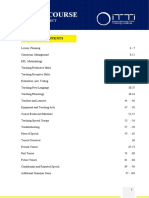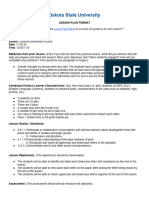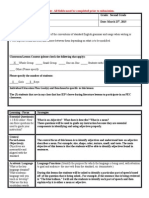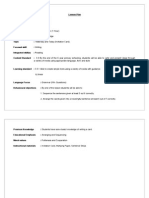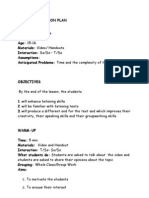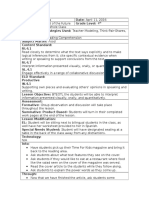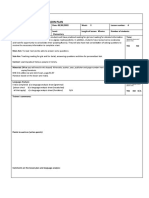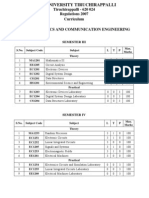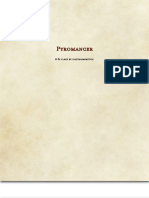Spring 2016 Reading Lesson Plan Rationale
Spring 2016 Reading Lesson Plan Rationale
Uploaded by
api-312579145Copyright:
Available Formats
Spring 2016 Reading Lesson Plan Rationale
Spring 2016 Reading Lesson Plan Rationale
Uploaded by
api-312579145Original Title
Copyright
Available Formats
Share this document
Did you find this document useful?
Is this content inappropriate?
Copyright:
Available Formats
Spring 2016 Reading Lesson Plan Rationale
Spring 2016 Reading Lesson Plan Rationale
Uploaded by
api-312579145Copyright:
Available Formats
Name: Ishmael Pluton
Date: 03/30/16
EDSE 457
Reading Lesson Plan Rationale Template
Complete this template and submit it with your lesson plan.
Be detailed and specific about each topic.
Your Content Area:
What were student
assigned to read?
The grade level this text
would be used with
Describe the content of
the text (What is the text
about? How is it
organized?)
Explain why students
might struggle with this
text
List the strategy/
strategies you chose to
use (jigsaw, guided notes,
cloze activity, graphic
organizer, etc.)
Social Science-History
The Declaration of the Rights of Man and the Citizen
10th grade Modern World History Class
The text is a lengthy document full of legal jargon. It is also
translated from its original language of French which may add
a degree of difficulty in comprehension due to the fact that it is
a translated text. That being said, the text follows the same
structure as the Declaration of Independence: an introduction
followed by a list of grievances. The grievances are being
directed toward the monarchy of France and the issues
inherent in the monarchys implantation of power and
governance.
The legal jargon alone may turn students away from reading
the document. It is also 2 pages long in size 11 font.
I used background knowledge, modeling, close reading
annotation, a jigsaw technique, and a microtheme in order to
help students work to understand the reading. I decided to
break the document down into 2 parts so that students could
tackle much more manageable sections of a document full of
Name: Ishmael Pluton
Date: 03/30/16
Explain why you chose
your strategies; how will
these activities help
students with this
particular text?
political jargon. After modeling both how to annotate a
document and how to complete the microtheme using the
document camera, I had students complete the microtheme
close reading of the document in their groups.
I chose to begin the lesson with a quick-write question that
engaged the students prior/background knowledge about
revolution. Since the text is full of jargon that is sometimes
difficult to follow, I broke the document into parts that students
could tackle and not feel as overwhelmed. In addition to that, I
chose to model how to fill out the microtheme with a thinkaloud so that students could see how a historian tackles a
difficult to read document. The fact that the microtheme
requires students to listen to other students findings helps
them better understand what they read in the document. The
idea being that academic conversations are promoted via the
microtheme.
Your teaching context: Be specific about how your lesson plan meets the
developmental needs of the class:
The class is interested in
The microtheme will be stamped at the end of class as an exit
your content area and
slip. This allows students a chance to not only write down their
they learn well when they
can apply their knowledge interpretations of the document, but also engage in academic
in a concrete manner.
conversations while doing so.
They can be talkative and
The microtheme jig-saw is how I am planning to use the
unfocused, but they are
talkative nature of my students to my advantage. I plan to
respectful and respond
make the time filling out the microtheme in groups very
well to redirection.
Name: Ishmael Pluton
Date: 03/30/16
structured along with constant roving of the room so that
academic conversations are encouraged.
Your students: Be specific about how your lesson plan meets the needs of the
students in the class with additional academic needs:
4 Intermediate ELLs
Warm-up:
(Explain why you chose
I chose the quick-write not only to get students ready to
your strategies; how will
engage in historical and academic thinking, but also so that
these activities help
students with this
they could start to draw connections from the French
particular text?_
Revolution to the American Revolution. Accessing prior
knowledge learned in the class can definitely help ELL students
contextualize and understand the text we are covering. The
think-pair-share structure of the warm-up also lowers
students affective filters, thus helping them feel more
comfortable engaging in academic conversations.
Modeling Close Reading Annotations:
This is especially helpful to ELL students because it is in the
form of a think-aloud. This demonstrates to students how to
think academically and annotate a challenging document.
Modeling Microtheme:
I modeled the microtheme so that there was no room for
confusion on how to complete it. This is not only helpful for ELL
students, but all other students as well.
Jig-Saw Microtheme of Reading:
This allows students to practice their oral language skills in an
academic setting, thus helping improve their literacy and
Name: Ishmael Pluton
Date: 03/30/16
4 IEP students (2 ADHD; 2
high-functioning ASD)
[Explain why you chose
your strategies; how will
these activities help
students with this
particular text?]
10 below-grade level
readers (2-4 years below
grade level) [Explain why
you chose your strategies;
how will these activities
fluency.
Warm-up:
I included a warm-up quick-write because that is the standard
structure of almost every lessons beginning. This allows
students with ASD to have a structured schedule to expect in
my class, and also gives students with ADHD a chance to shift
modes and begin to focus on the task of engaging with the
content of the class.
Modeling Close Reading Annotations:
By breaking down the close reading process into chunks and
modelling it for students, the information is not as daunting.
Students with ADHD have a more focused look at the
document, and students with ASD have a structure and plan to
follow when tackling primary source documents.
Modeling Microtheme:
Simply giving instructions without modelling would not result in
the desired results for all students, but would pose more
challenges for students with ASD and ADHD. Therefore, I chose
to model how to complete the activity.
Jig-Saw Microtheme of Reading:
This section breaks down the text into smaller focus areas for
the students with ADHD and gives students with ASD practice
engaging in social and academic conversations.
Warm-up:
Students that are below-grade-level readers need as many
opportunities as possible to engage in literacy. Therefore,
Name: Ishmael Pluton
Date: 03/30/16
help students with this
particular text?]
having students start the day with a writing task is incredibly
beneficial and helpful for students who read below grade level.
Modeling Close Reading Annotations:
This is necessary so that students have a strategy that they
cannot only use within the content area of history, but across
academic disciplines.
Modeling Microtheme:
Modeling the microtheme is just beneficial to instruction in
general because it leaves little to no doubt that students will
understand how to complete the task they have been
assigned.
Jig-Saw Microtheme of Reading:
This helps fill in the gaps for students who may not have
understood their portion of the document in its entirety. By
working with a partner on the same section, and then with the
group for the whole document, students that read below grade
level can understand almost the same amount of information
in the document as other students. In addition to improving
comprehension in that particular class period, students have a
chance to learn from their peers on how to approach difficult to
read documents.
You might also like
- Justification and Rationale of The Selected Activity and The Lesson Plan PreparedDocument2 pagesJustification and Rationale of The Selected Activity and The Lesson Plan PreparedMc Cruzt KristoferNo ratings yet
- First LP Tefl Lesson Plan Template 2019 Speaking ListeningDocument2 pagesFirst LP Tefl Lesson Plan Template 2019 Speaking Listeningapi-467343920No ratings yet
- Writing Lesson PlanDocument39 pagesWriting Lesson Planapi-482714429No ratings yet
- Holly Mette SPD 580 Benchmark ELA Unit PlanDocument4 pagesHolly Mette SPD 580 Benchmark ELA Unit PlanHolly Mette0% (1)
- Testing: Reasons For Testing StudentsDocument6 pagesTesting: Reasons For Testing StudentsDobreanu SoranaNo ratings yet
- Dream School Lesson PlanDocument4 pagesDream School Lesson Planalex_medeiros_16100% (1)
- Lesson Plan Week 13 For English Year 4Document6 pagesLesson Plan Week 13 For English Year 4AbdulRahimJaafarNo ratings yet
- Teaching Language ConstructionDocument5 pagesTeaching Language ConstructionManyu RadjabliNo ratings yet
- The Court of Ava in 1855Document417 pagesThe Court of Ava in 1855amaradipa100% (2)
- Lesson Plan 1Document4 pagesLesson Plan 1api-252771265100% (1)
- Lesson Plan - Birth OrderDocument3 pagesLesson Plan - Birth OrderAlina LazaruicaNo ratings yet
- Lesson Plan GrammarDocument3 pagesLesson Plan GrammarCaca CacosNo ratings yet
- Vocabulary Lesson Plan Rationale 2016Document7 pagesVocabulary Lesson Plan Rationale 2016api-312579145100% (1)
- Writing LessonpdfDocument11 pagesWriting Lessonpdfapi-402570316No ratings yet
- Lesson Plan (Lexis)Document2 pagesLesson Plan (Lexis)Гульмира Лучезарная50% (2)
- Lesson Plan VocabularyDocument2 pagesLesson Plan VocabularyLavinia NimerschiNo ratings yet
- CS2Document96 pagesCS2Ramez NashatNo ratings yet
- Long e Using Ea LessonDocument8 pagesLong e Using Ea Lessonapi-282071638No ratings yet
- Lesson Plan 2 - VocabularyDocument2 pagesLesson Plan 2 - Vocabularymasia22No ratings yet
- Teaching PortfolioDocument21 pagesTeaching PortfolioAmrita KaurNo ratings yet
- Contextual Learning: Preparation PhaseDocument4 pagesContextual Learning: Preparation PhaseAnonymous Df2gbAA6jCNo ratings yet
- Lesson Plan A1-A2Document3 pagesLesson Plan A1-A2Steven KadirNo ratings yet
- Past Perfect-Lesson PlanDocument6 pagesPast Perfect-Lesson Planzola1975No ratings yet
- Thunder Cake-RevisionsDocument7 pagesThunder Cake-Revisionshsmith15No ratings yet
- Project TESOL (Sevinj Nasraddinli)Document22 pagesProject TESOL (Sevinj Nasraddinli)Sevinc NasraddinliNo ratings yet
- Hanoi National University - 2Document23 pagesHanoi National University - 2Trang TrầnNo ratings yet
- Lesson Plan RationaleDocument15 pagesLesson Plan Rationaleaarikapinkfloyd100% (1)
- Small Group Lesson Plan FishingDocument4 pagesSmall Group Lesson Plan Fishingapi-594519491No ratings yet
- Prac Lesson Plan Primary EnglishDocument6 pagesPrac Lesson Plan Primary Englishapi-293527475No ratings yet
- Lesson Plan For Writing A Fictional Narrative 1st GradeDocument23 pagesLesson Plan For Writing A Fictional Narrative 1st GradeMelina ArriazaNo ratings yet
- Ib Lesson Plan-VocabularyDocument6 pagesIb Lesson Plan-Vocabularyapi-265303985No ratings yet
- Lesson Plan Grade 7 Unit 8: Films Lesson 5: Skills 1-Reading & Speaking (Page 22)Document15 pagesLesson Plan Grade 7 Unit 8: Films Lesson 5: Skills 1-Reading & Speaking (Page 22)Nguyễn ViệtNo ratings yet
- Task-Based LearningDocument9 pagesTask-Based LearningKatherine MondaNo ratings yet
- Present Continuous and Going To (Grammar)Document2 pagesPresent Continuous and Going To (Grammar)Logeswariy SelvarajuNo ratings yet
- Lesson-Plan-Template - COURSERADocument2 pagesLesson-Plan-Template - COURSERAShekinah Love Medalla100% (1)
- Smith Task1 LPDocument20 pagesSmith Task1 LPapi-270543710No ratings yet
- Writing Lesson PlanDocument4 pagesWriting Lesson Planapi-273739794No ratings yet
- Lesson Plan - Student ProfileDocument2 pagesLesson Plan - Student Profilejen_s_davis2461No ratings yet
- Siop Lesson PlanDocument4 pagesSiop Lesson Planapi-526732984No ratings yet
- Lesson Plan Listening and SpeakingDocument3 pagesLesson Plan Listening and SpeakingMilz VemNo ratings yet
- Daily Lesson Plan Year 6 English: Date / Day Time /class Theme Topic Main Skill & Integrat Ed Skills ActivitiesDocument7 pagesDaily Lesson Plan Year 6 English: Date / Day Time /class Theme Topic Main Skill & Integrat Ed Skills ActivitiesMunirah HarunNo ratings yet
- Phonological Lesson PlanDocument2 pagesPhonological Lesson Planapi-339903426100% (1)
- Lesson Plan Writing Unit 3 (Year 4)Document7 pagesLesson Plan Writing Unit 3 (Year 4)Christer Ronald SaikehNo ratings yet
- Hill, Tomlinson (2003) - Coursebook Listening ActivitiesDocument11 pagesHill, Tomlinson (2003) - Coursebook Listening ActivitiesMelina San Miguel GarciaNo ratings yet
- Listening L.P.Document4 pagesListening L.P.Nazann TekinNo ratings yet
- Food of The Future TFK Lesson and ReflectionDocument2 pagesFood of The Future TFK Lesson and Reflectionapi-307027477No ratings yet
- Justification of Activities (Reading)Document3 pagesJustification of Activities (Reading)Amirul AsyrafNo ratings yet
- Lesson 14 - PluralsDocument9 pagesLesson 14 - PluralsNurture ProgrammeNo ratings yet
- Tesol ReadingDocument7 pagesTesol ReadingWasif100% (1)
- Reading Method vs. Audiolingual MethodDocument1 pageReading Method vs. Audiolingual MethodTrong Nguyen ManhNo ratings yet
- Mintzer Final Siop ActivitiesDocument5 pagesMintzer Final Siop Activitiesapi-251583101No ratings yet
- PCELT PortfolioDocument2 pagesPCELT PortfolioReham Ismail100% (2)
- TP4 Lesson PlanDocument4 pagesTP4 Lesson PlanFr Jesmond MicallefNo ratings yet
- SIOP Lesson Plan: Ontext AckgroundDocument3 pagesSIOP Lesson Plan: Ontext Ackgroundapi-418545731100% (1)
- 10vocab Vowels Lesson PlanDocument4 pages10vocab Vowels Lesson Planapi-236893416No ratings yet
- Giao An Tieng Anh 11Document156 pagesGiao An Tieng Anh 11Carter RuanNo ratings yet
- Spede 774 Writing Lesson PlanDocument4 pagesSpede 774 Writing Lesson Planapi-273589202No ratings yet
- Reading To Learn Lesson 1 PracticumDocument3 pagesReading To Learn Lesson 1 Practicumapi-300554601No ratings yet
- Lesson Plan Template-Writing - (Group 5)Document2 pagesLesson Plan Template-Writing - (Group 5)Mohd HanizaNo ratings yet
- CD Course AssessmentDocument18 pagesCD Course AssessmentHuỳnh ThạchNo ratings yet
- CV - Ishmael Pluton GeneralDocument4 pagesCV - Ishmael Pluton Generalapi-312579145No ratings yet
- Lesson Plan 1 Vocabulary Ss VersionDocument2 pagesLesson Plan 1 Vocabulary Ss Versionapi-312579145No ratings yet
- Lesson Plan 2 Source DocumentsDocument7 pagesLesson Plan 2 Source Documentsapi-312579145No ratings yet
- Lesson Plan 2 Explicit Historical Thinking SkillDocument5 pagesLesson Plan 2 Explicit Historical Thinking Skillapi-312579145No ratings yet
- B.e.ece Syllabus RoboticsDocument87 pagesB.e.ece Syllabus Roboticsanand787No ratings yet
- Kartu Soal Ujian Sekolah Berstandar Nasional (Usbn) TAHUN PELAJARAN 2018/2019 SMA NEGERI 1 KuripanDocument7 pagesKartu Soal Ujian Sekolah Berstandar Nasional (Usbn) TAHUN PELAJARAN 2018/2019 SMA NEGERI 1 KuripanNurul HikmahNo ratings yet
- At The Completion of Module 5, You Should Be Able ToDocument7 pagesAt The Completion of Module 5, You Should Be Able ToJohn Carl B. AparicioNo ratings yet
- DLL g6 q2 Week 2 All Subjects (Mam Inkay Peralta)Document57 pagesDLL g6 q2 Week 2 All Subjects (Mam Inkay Peralta)Ellanie Pujalte Montebon100% (2)
- Pre Analytical Phase in HistopathologyDocument23 pagesPre Analytical Phase in HistopathologyKirsten Valenzuela100% (1)
- Sample Call Flow For Graded Role PlayDocument2 pagesSample Call Flow For Graded Role PlayLloyd Eman BalucosNo ratings yet
- English Let LitDocument16 pagesEnglish Let LitRizza Mae Garcia RequinaNo ratings yet
- Paternina-Die Et Al-2024-Nature NeuroscienceDocument18 pagesPaternina-Die Et Al-2024-Nature NeuroscienceRamón Díaz-AlersiNo ratings yet
- Mesophilic Temperature, Neisseria, Brucella, Campylobacter, and Many Other Bacteria RequireDocument1 pageMesophilic Temperature, Neisseria, Brucella, Campylobacter, and Many Other Bacteria RequirePriyam RamsokulNo ratings yet
- Ecocriticism Sample Research ResultsDocument1 pageEcocriticism Sample Research ResultsAnonymous FHCJucNo ratings yet
- 024 - Mercado Vs ManzanoDocument2 pages024 - Mercado Vs ManzanoPatrick ManaloNo ratings yet
- Final Assignment EU External RelationsDocument10 pagesFinal Assignment EU External RelationsAndrei UngureanuNo ratings yet
- EE200 SSN Sandhan L06 RemovedDocument44 pagesEE200 SSN Sandhan L06 RemovedshreyaiotaNo ratings yet
- Article On Athletes Coping InjuryDocument2 pagesArticle On Athletes Coping InjuryAnna Marie L. MalulanNo ratings yet
- 1st Putnam 1938Document2 pages1st Putnam 1938Võ Thượng AnhNo ratings yet
- Test Methodology PDFDocument29 pagesTest Methodology PDFkumard205No ratings yet
- Sports Tourism A New Paradigm Shift in The Tourism Industry of AssamDocument5 pagesSports Tourism A New Paradigm Shift in The Tourism Industry of AssamarcherselevatorsNo ratings yet
- Java Programs1Document58 pagesJava Programs1Pushpalatha AlavalaNo ratings yet
- HPMOR Review Work FinalDocument118 pagesHPMOR Review Work FinalCatnip MeepNo ratings yet
- Odiare 5th EditionDocument15 pagesOdiare 5th EditionKolaNo ratings yet
- Consumer Preference Towards Different Branded Sports ShoesDocument11 pagesConsumer Preference Towards Different Branded Sports ShoesAnushka KharatNo ratings yet
- Conveyor Trajectory Prediction Methods - A Review: Research OnlineDocument16 pagesConveyor Trajectory Prediction Methods - A Review: Research OnlineubabNo ratings yet
- Was HJR RepealedDocument4 pagesWas HJR RepealedCynthia Cornell100% (2)
- Expository TextDocument7 pagesExpository TextKristen Mitra Olan CalangianNo ratings yet
- UntitledDocument18 pagesUntitledKing Jeblinx JosephNo ratings yet
- Biographical Study of LiteratureDocument5 pagesBiographical Study of Literatureapi-294041566No ratings yet
- Pyromancer 5e Class - GM BinderDocument11 pagesPyromancer 5e Class - GM BinderАлексей ЖуравлевNo ratings yet
- Beluso vs. Municipality of Panay Gr. No. 153974Document7 pagesBeluso vs. Municipality of Panay Gr. No. 153974arriane joy insularNo ratings yet
- Palfique Asteria ClinicalguideDocument32 pagesPalfique Asteria Clinicalguidemaroun ghalebNo ratings yet
























